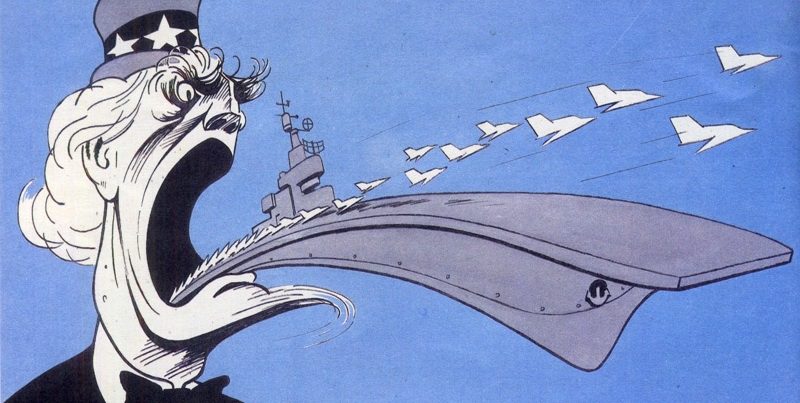After plans to draw Russia into an open conflict with the Weston Ukrainian territory failed, USA and its European allies started working out an alternative option. In the Western media, pieces on Russia’s impending attack on the Baltics started appearing one after the other. This flood of publications has all of the signs of a planned information campaign. The goal of this information campaign and other USA and NATO actions in the region is to convince Russia that the Baltics are actually an easy target, which can be attacked with no repercussions.
In political science, there is a theory called “Overton window”. The theory states that even the most insane and unthinkable ideas, concepts and suggestions can be made a social norm, if they are implemented in stages, and forced to the public opinion. From insane ideas they will turn to simply radical, then into acceptable, and then into commonplace things. The important part is that they get into the “window” of opportunity, so from undoubtedly unacceptable they become actually open to debate.
For example, a year ago, even after the Crimean events, the Western political and expert society considered it clearly impossible that Russia could attack the North Atlantic Alliance member-states. However, after a year of hard work from Western media, politicians and experts from amongst the radical hawks led to the suggestion that the Russian President Putin doesn’t care about the Article 5 of the NATO Charter on collective defense, and the idea that Russia may attack Poland or the Baltics is just radical and not impossible.
The idea of Russian aggression against a country or group of countries within NATO made it through the Overton window, and the hawks are convincing Russia that this idea is plausible.
“After Russia annexed Crimea and destabilized the situation in Eastern Ukraine, the military confrontation between Moscow and the West over the Baltic countries seems fairly possible”, wrote . “As an option, Russia could seize the Baltic countries as part of a daring operation, possible with the relatively small armed forces of these countries. However, a “sudden” capture is unlikely, because Russia would have to find an excuse for its actions at all costs. The less dire option of this scenario would have been a deployment of Russian troops in Estonian and Latvian territory, who are close to the Russian border and who have a considerable amount of ethnic Russians. Or the capture of the most important infrastructural sites – ports, airports and railways”.
“Lithuanian President Dalia Grybauskaite once again criticized the Kremlin in Brussels. She demanded to strengthen the sanctions against Russia. Negotiating with an “aggressor country” was “useless” according to the president”, . According to said article, the Lithuanian leaders are most concerned about the Iskander missiles (SS-26 Stone in NATO reports) deployed in Kaliningrad. They are handing out brochures in schools about what to do in case of bomb strikes, and are conducting anti-air artillery drills. There were never this many army men on the streets of Vilnius as there are now.”
Kurier notes that, during the first three days of Russian aggression, Lithuania will be on its own. The same is said by the , “I believe that the Poles should be ready to fight alone for a while. In case of an attack on any NATO country, the following NATO actions may paralyze one of the Alliance’s sections. Meaning that they can contest the use of Article 5, using their veto right. In today’s circumstances, this almost certainly may be Greece. In this case, the Poles will have to fight alone for a while.”
So the Western hawks are openly hinting that Article 5 of the NATO Charter may not apply to the Baltics and/or Poland and may fail. They are also hinting this to Russia – go ahead and attack.
Financial Times even thinks up excuses for Putin to use for the invasion. “Ethnic Russians comprise a fourth of the Baltic countries’ population. Many thousands of ethnic Russians were denied their citizenship. So there are serious concerns within the Baltics about a possible Russian intervention… It is completely possible that Russia might try to repeat such actions (a “Ukrainian scenario” – RuBaltic.ru ) in the Baltic countries, and, after a few months of military engagements, demand the resolution of the conflict with a peace treaty, which would allow the ethnic Russians more rights in deciding issues of internal and foreign policies of Estonia, Latvia and Lithuania”. It is worth noting that the British media doesn’t even deny that there are problems with the rights of ethnic Russians in the Baltics. But it is not proposing that the Baltics solve these issues in order to ease the tension. On the contrary, Yoel Sano is hinting on how Russia could fix this problem: organize a political destabilization or even a direct military intervention into the Baltics.
At the same time, the intensified militarization of the Baltics continues (which triggered the response of deploying Iskander missile complexes in Kaliningrad region).
Experts from both Russia and abroad admit that there is no real threat to the Baltics from Russia, and Article 5 protects all Alliance members equally. “I think that a Russian attack on the Baltics is extremely unlikely. There is Article 5 of the NATO Charter about collective defense”, said American journalist Michael Bohm to RuBaltic.Ru. “There exists a very popular story, according to which, the wicked strategy of Russia is to test the durability of the Article 5. That means torpedoing the collective defense guarantee, putting USA in an awkward position in front of its allies to show the world that the US guarantees aren’t worth anything, and this can mean long-term consequences. Such a theory exists. Russia’s goal to acquire Crimea was on the first place, obviously, but with that Russia gained a good secondary profit – disrupting American security guarantees to Ukraine. USA posed (along with Russia, by the way) as guarantors of the territorial integrity of Ukraine, when Washington and Moscow signed the Budapest Memorandum in 1994. As result of violation of this memorandum – and, subsequently, of US security guarantees to Kiev – other American allies, like Japan and South Korea, began asking questions, “What are US security guarantees worth to us?” But it was a memorandum, not a treaty. While the North Atlantic Treaty, under which the NATO was established, in 1949, and later expanded to 28 member-states, is a holy cause. It is the backbone, the foundation of the European security and the security of Trans-Atlantic union. Therefore, the said theory about the Russia’s attempt to disrupt the basic NATO guarantee is very unlikely. Putin is no fool. Maybe, to some extent, it is tempting to disrupt the NATO foundation, but it is too risky and unrealistic. So I think that there is no real threat to the Baltics. It is unlikely that Putin will make a step to attempt to disrupt the Article 5 of NATO.”
The only real threat to the Baltic countries comes from NATO’s own provocations. “USA and NATO activity in the Baltics is escalating, this trend is completely obvious, and a good illustration of this is the arrival of 150 armored units to Latvia for war games. In addition to that, the Baltic states are now home to United States of America special operations departments on a constant basis, who are tasked with either war or pre-war activities. This is very serious. It is obvious that new large air force bases in Lithuania and Estonia will be used for NATO’s electronic reconnaissance on all of the Baltics’ territory in immediate proximity to Russian borders. And NATO’s tactical aviation and naval forces will use airports and sea ports of the Baltics to work out their battle plans”, said Russian military expert and editor-in-chief of National Defense Igor Korotchenko. “During the latest NATO war games, they were practiced two objectives: the occupation of the Kaliningrad region, and blocking and destroying the Baltic Fleet. And we can’t count out the prospect that the NATO air forces, who are currently in rotation, and later on a permanent basis, staying in the Baltic states, could be used to American tactical nukes, which is in Europe. So all of this means that the gun is not just hanging on the wall, but it could fire at any moment”, said Korotchenko to RuBaltic.ru
So the Baltics are steadily being transformed into a foothold for an attack on Russia. While also encouraging Russia to attack the Baltics, letting it know that it is not impossible as the collective defense article may not work, and there is a guaranteed reason to end the discrimination of the Russian-speaking minority, which the Western allies aren’t even trying to combat in order to take that excuse away from Putin. And finally, there is still time before the foothold is complete.
After Russia somehow avoided the almost stalemate in Donbass, retaining their support of the self-proclaimed republics, but not bringing in their own troops unto Ukrainian territory. The Western hawks are calculating a new strategy: to provoke Russia into attacking the Baltics and drag it directly into a full-scale military conflict.
Russian leadership in the meantime is determined not to fall on this lure. In the Russian Federation Security Council statements last year it was said multiple times, that there are attempts to drag Russia into a military conflict, but Moscow won’t allow that to happen. And if so, then to actually draw Russia into war you need a provocation. And the best provocateurs are the leaders of the Baltic countries, who are also the planned objects of Russian aggression. However, in the ensuing fight the provocateurs are also the first in line for destruction. But this is not new: that is the fate of all provocateurs.







